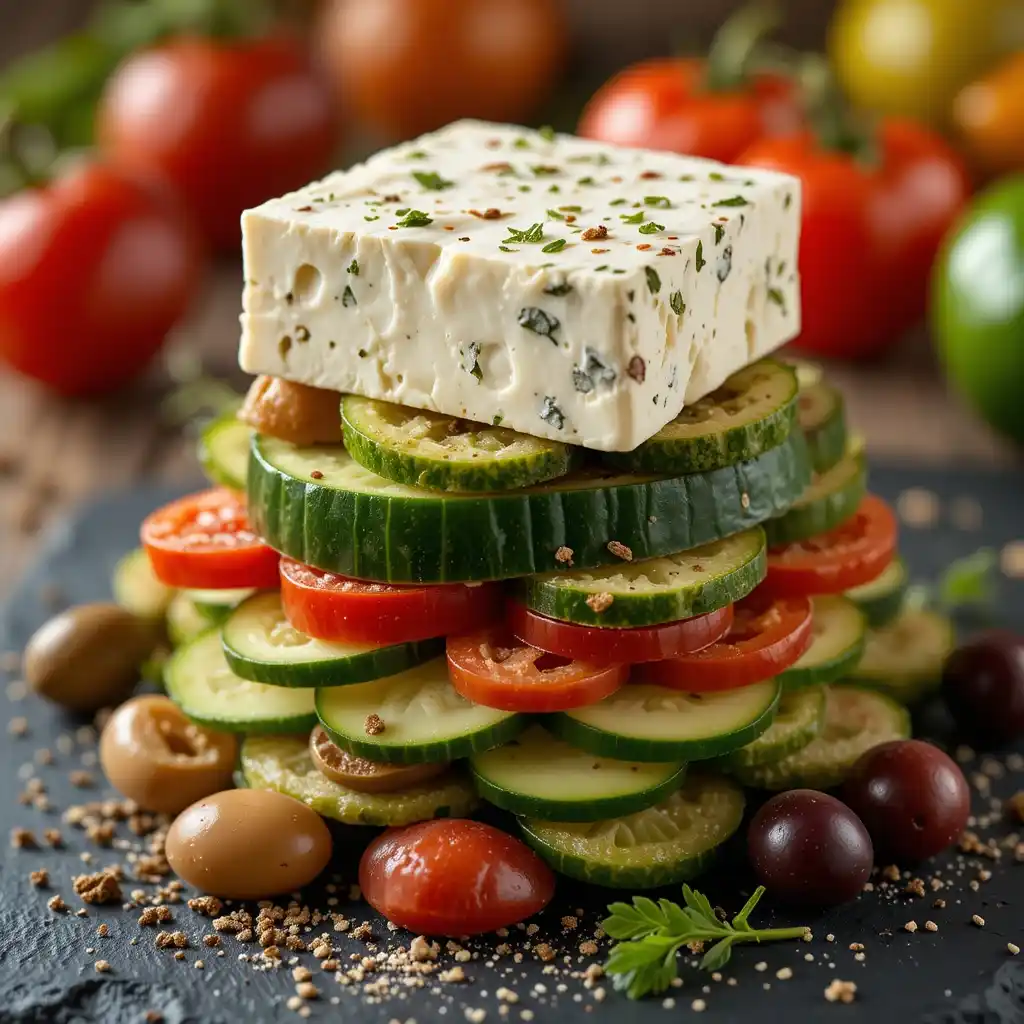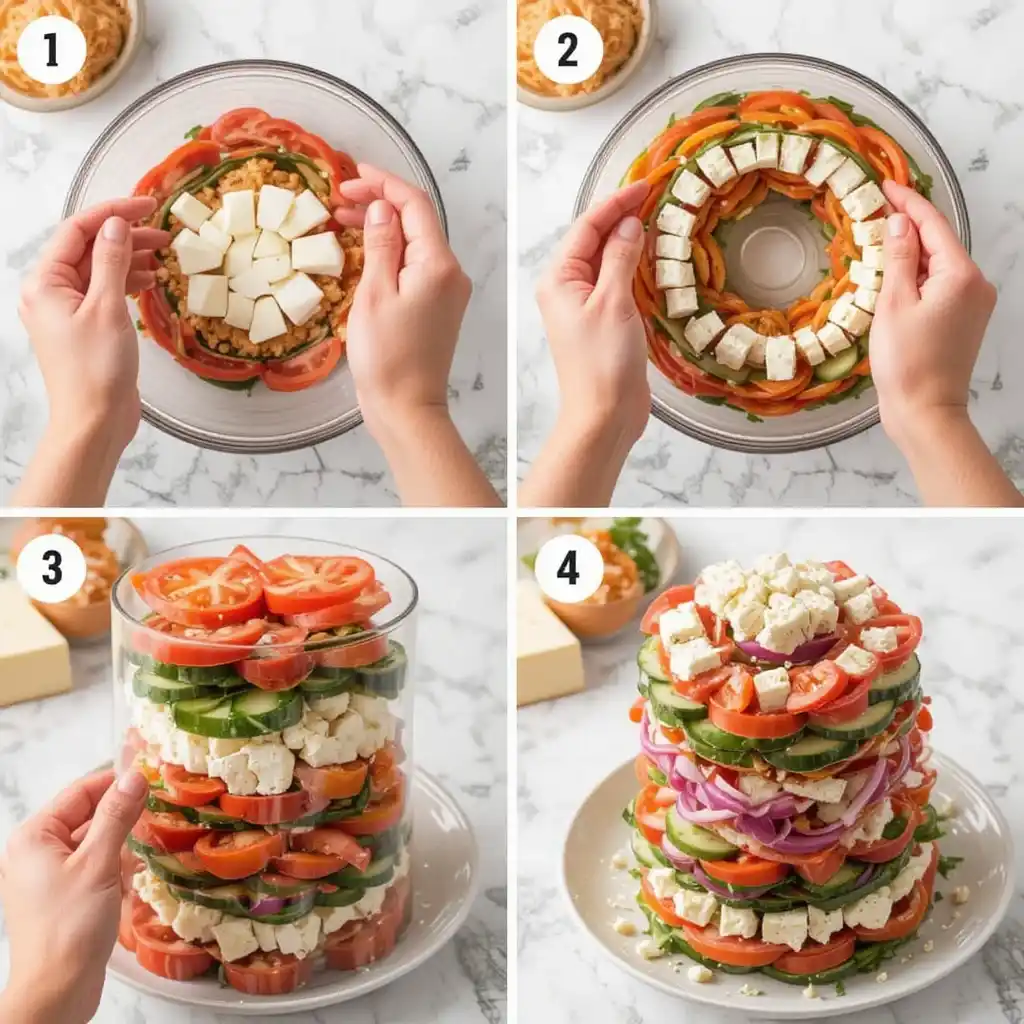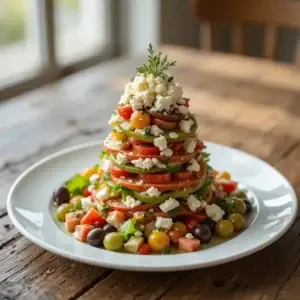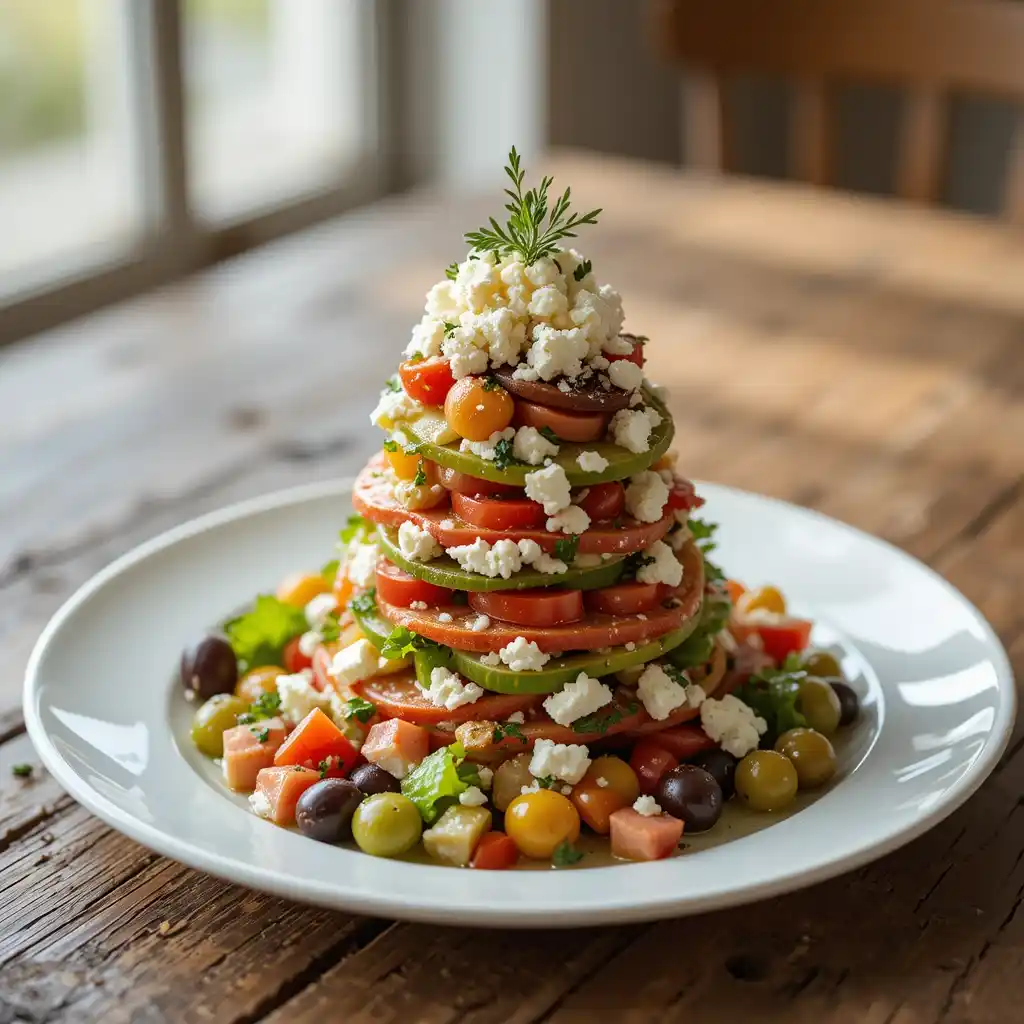The Greek name “Horiatiki” for traditional Greek salad translates to “peasant salad” or “village salad.”
This classic dish combines chunky vegetables with substantial slabs of feta cheese. The humble village meal has become an elegant offering that appears on tables throughout spring, summer and fall. A traditional Greek salad needs just 15 minutes of preparation time, yet these simple ingredients can create a stunning restaurant-quality presentation.
We will show you how to lift this authentic Greek salad into an impressive tower with professional techniques. The process starts with selecting perfect tomatoes and cucumbers. You will become skilled at building this rustic dish into a showstopping centerpiece while preserving its Mediterranean charm.
Let’s create a masterpiece that’s as beautiful as it is delicious!
Table of contents
Essential Ingredients for an Authentic Greek Salad Tower

A stunning Greek salad tower starts with premium ingredients that stay true to Mediterranean tradition.
Selecting the Perfect Vegetables
Fresh vegetables are the foundations of a traditional Greek salad. Ripe, medium-sized tomatoes work best as they stay firm when cut into wedges. The crispness and fewer seeds make Persian or English cucumbers ideal choices. Green bell peppers sliced horizontally into strips add that classic bitter note your authentic Greek salad needs.
Sharp, peppery notes come from red onions. You can soften their bite by soaking thinly sliced onions in ice water with a teaspoon of red wine vinegar for 10 minutes before assembly.
Choosing Quality Feta and Olives
High-quality feta cheese is without doubt the star of any Greek salad tower. Sheep’s milk feta stored in brine delivers the best flavor and creamiest texture. The sharp, tangy profile of Greek feta makes it perfect for layering in a tower presentation.
Kalamata olives are the life-blood of briny flavor. Buy these dark purple, almond-shaped olives whole with pits intact. Their smooth, meaty texture and rich taste blend perfectly with other ingredients.
Fresh Herbs and Seasonings
Traditional Greek salads rely on dried oregano as their signature herb. This Mediterranean herb actually tastes better in its dried form, with deeper and more concentrated flavors. Bright notes can come from fresh dill and parsley, though these are modern additions to the classic recipe.
Sea salt plays a crucial role, especially when you have Mediterranean ingredients. A simple yet flavorful dressing combines extra virgin olive oil with red wine vinegar that brings out the best in each tower layer.
Your ingredient proportions should include:
- 2 cups diced cucumber (unpeeled)
- 2 cups diced red bell peppers
- 3 cups seeded and diced tomatoes
- 1/3 cup finely chopped red onion
- 1/2 cup Greek green olives
- 1/3 cup crumbled feta
Professional Tools and Techniques for Tower Construction
A professional-grade Greek salad tower requires you to become skilled at using specific tools and techniques that raise this classic dish from simple to spectacular.
Ring Molds and Plating Cylinders
Ring molds are the life-blood of tower construction that reshape the scene from ordinary ingredients into architectural masterpieces. These cylindrical tools are available in different diameters and heights to give versatility for different serving sizes. Your best choice would be a mold with enough space for gentle layering without overcrowding the ingredients.
The best results come from preparing all components beforehand and arranging them in order of assembly. Dense ingredients should go at the base as you gradually work up to more delicate items. This systematic approach will give a tower that maintains its shape after removing the mold.
Knife Skills for Uniform Cutting
Precise knife work creates the foundations of a visually striking salad tower. A sharp chef’s knife and a sturdy cutting board provide the perfect setup for consistent cuts. Vegetables like tomatoes and cucumbers need uniform sizes to ensure even distribution throughout the tower.
The oblique cut, also called the roll cut, works best for cylindrical vegetables and creates pieces with multiple sides that stack efficiently. Delicate herbs and smaller ingredients need the mincing technique that yields tiny, uniform pieces perfect for garnishing.
Compression Techniques
Compression is crucial to create a stable tower structure. Chef Mark Hopper at Bouchon in Las Vegas pioneered this technique that removes air between cell walls and enhances both flavor and structural integrity. Gentle compression helps create denser layers that hold their shape with porous vegetables like cucumbers.
Each layer needs gentle pressure to secure it without crushing the components below. Careful hand compression works well while building each layer if you don’t have a vacuum sealer. Delicate ingredients like crumbly feta or tender herbs need extra care during handling.
Step-by-Step Assembly of Your Greek Salad Tower

Building a Greek salad tower needs care and attention to create a beautiful presentation that stays intact. Here’s how to layer ingredients and turn them into an impressive culinary creation.
Creating a Stable Base Layer
Place the bottom tomato slice in the middle of your serving plate. Cut a small slice from the tomato’s bottom so it doesn’t wobble. Add cucumber slices evenly on the tomato base and top them with thin red onion rings. A light touch of salt brings out the flavors in this first layer.
Building the Middle Layers
Stack tomatoes and cucumbers in alternating layers while keeping them the same thickness. Add a thin red onion slice and some feta cheese after each vegetable layer. Press down gently after adding each layer to help them stick together without damaging the ingredients below.
The best visual results come from using 60% tomatoes and 40% English cucumbers in the middle sections. Large tomatoes work great in summer, but cherry or campari tomatoes taste better and provide better structure during other seasons.
Crowning Your Tower
The top layer makes the final impression. Pick your best tomato slice to crown the tower, or you can use the tomato stem as a decorative finish. Place kalamata olives and leftover feta pieces around the plate’s edge.
Removing the Mold Without Collapse
Taking off the ring mold is a vital step. Keep the tower steady with one hand and lift the mold straight up. You can serve individual portions using two wooden spoons or tongs – place them straight down to grab the bottom layer, then lift up to collect each layer above.
Add the classic Greek dressing right before serving. Let it flow down the sides of your tower. This final step adds flavor and creates an appealing look that makes your dish look restaurant-quality.
Restaurant-Style Dressing and Garnishing
The final touches of a Greek salad tower come from its dressing and garnishing. These elements turn this classic dish into a visual masterpiece.
Classic Greek Dressing Preparation
A traditional Greek vinaigrette blends red wine vinegar, extra virgin olive oil, Dijon mustard, garlic, and dried oregano. Fresh lemon juice creates a zesty touch that brightens the flavor profile. You can achieve restaurant-quality consistency by whisking the vinegar, lemon, mustard, and seasonings first. Then slowly stream in the oil to create an emulsified texture.
Drizzling Techniques for Visual Appeal
Expert chefs use a layered approach instead of adding dressing at once. Each level of the tower needs a small drizzle that ensures even distribution. A spoon or squeeze bottle helps create artistic patterns around the plate’s edges during final presentation.
Edible Garnishes That Enhance Presentation
Your salad tower’s garnishes should boost both its looks and taste. Fresh oregano leaves and cracked black pepper add an authentic final touch. Kalamata olives and feta crumbles placed around the base create striking contrast against white plates.
The visual impact improves when you:
- Position a key ingredient in the center as focal point
- Leave intentional negative space to highlight components
- Choose dark-colored plates to make ingredients pop
Store any leftover dressing in an airtight container in your refrigerator. The olive oil might solidify when cold, so bring it to room temperature and shake it well before use. A small amount of honey or Greek yogurt can balance the dressing’s acidity perfectly.
These professional techniques for dressing and garnishing will help your Greek salad tower fascinate both eyes and palate, delivering an exceptional restaurant-worthy experience.
Conclusion
A Greek salad tower raises a simple Mediterranean dish to an impressive culinary masterpiece. Anyone can create this stunning presentation at home with premium ingredients, proper tools, and professional techniques.
Note that the details make all the difference – from selecting firm vegetables and quality feta to precise knife cuts and careful layering. Each component contributes to a perfect restaurant-worthy tower that stands tall and proud.
The elegant presentation preserves the authentic flavors of a traditional Greek salad while adding visual drama to your table. Your guests will be amazed by towers that rival those in upscale restaurants once you master these techniques.
Explore More Delicious Recipes:
If you loved creating this stunning Greek Salad Tower , why not try your hand at these other fantastic recipes?
- Crispy Parmesan Zucchini Potato Muffins : Perfect for a savory snack or side dish, these muffins are packed with flavor and crunch. Get the recipe here .
- How to Make Carrot Design on Cake : Add an artistic touch to your desserts with this creative guide to crafting beautiful carrot designs on cakes. Learn more here .
- Pink Punch Smoothie Recipe : Brighten your day with this refreshing and vibrant smoothie that’s as delicious as it is Instagram-worthy. Try it now .

Greek Salad Tower
Equipment
- Ring Mold
- Sharp Knife
Ingredients
Greek Salad Base
- 2 cups cucumber diced, unpeeled
- 2 cups red bell peppers diced
- 3 cups tomatoes seeded and diced
- 1/3 cup red onion finely chopped
- 1/2 cup Greek green olives pitted
- 1/3 cup feta cheese crumbled
Greek Dressing
- 3 tbsp extra virgin olive oil
- 1 tbsp red wine vinegar
- 1 tsp Dijon mustard
- 1 clove garlic minced
- 1 tsp dried oregano
- 1 tsp fresh lemon juice
Instructions
- Prepare all vegetables by dicing cucumbers, red bell peppers, and tomatoes. Finely chop red onion.
- Soak red onion slices in ice water with a teaspoon of red wine vinegar for 10 minutes to reduce sharpness.
- In a small bowl, whisk together olive oil, red wine vinegar, Dijon mustard, minced garlic, dried oregano, and lemon juice to create the dressing.
- Place a ring mold on a serving plate and start by layering a stable base of diced tomatoes.
- Add alternating layers of cucumber, red bell pepper, and red onion, pressing gently between each layer to ensure stability.
- Sprinkle feta cheese and olives throughout the layers for a balanced distribution.
- Once the tower is assembled, carefully remove the ring mold by lifting it straight up.
- Drizzle the Greek dressing over the tower, letting it naturally flow down the sides.
- Garnish with extra feta crumbles, fresh oregano, and cracked black pepper. Serve immediately.

